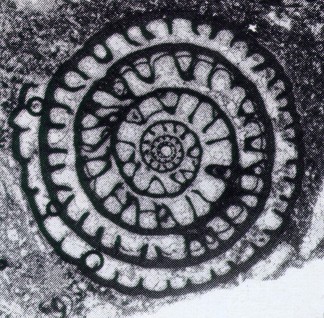
home
| Faunal Effects: Foraminifera |
Foraminifera are relatively tiny marine organisms, the largest of which can grow a few centimeters in diameter. Forams are single celled eukaryotes and a phylum of the kingdom Protista. They possess porous tests composed of calcium carbonate, silica or agglutinated sand. (Hemleben, 1989) Foraminifera display a steady decline during the Permian culminating in a rapid drop at the Permian-Triassic boundary. (Taylor, 1988) Architecturally complex groups were most heavily affected, especially those in tropical shelf environments. Fusulinids, the dominant benthic forams of the Permian, were up to 1.4 cm long and were totally wiped out at the end of the Permian. (Brasier, 1988) |

Figure: A foram from the Fusulinidae family